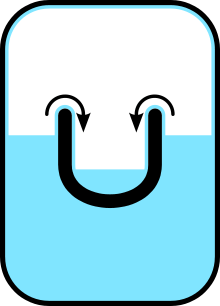Superfluidity
Superfluidity is the characteristic property of a fluid with zero viscosity which therefore flows without loss of kinetic energy. When stirred a superfluid forms cellular vortices that continue to rotate indefinitely. Superfluidity occurs in two isotopes of helium, helium-3 and helium-4, when they are liquified by cooling to cryogenic temperatures. It is also a property of various other exotic states of matter theorized to exist in astrophysics, high-energy physics, and theories of quantum gravity. The phenomenon is related to Bose–Einstein condensation, but neither is a specific type of the other: not all Bose-Einstein condensates can be regarded as superfluids, and not all superfluids are Bose–Einstein condensates.


Superfluidity of liquid helium
Superfluidity was originally discovered in liquid helium, by Pyotr Kapitsa and John F. Allen. It has since been described through phenomenology and microscopic theories. In liquid helium-4, the superfluidity occurs at far higher temperatures than it does in helium-3. Each atom of helium-4 is a boson particle, by virtue of its integer spin. A helium-3 atom is a fermion particle; it can form bosons only by pairing with itself at much lower temperatures. This process is similar to the electron pairing in superconductivity.
Ultracold atomic gases
Superfluidity in an ultracold fermionic gas was experimentally proven by Wolfgang Ketterle and his team who observed quantum vortices in 6Li at a temperature of 50 nK at MIT in April 2005.[1][2] Such vortices had previously been observed in an ultracold bosonic gas using 87Rb in 2000,[3] and more recently in two-dimensional gases.[4] As early as 1999 Lene Hau created such a condensate using sodium atoms[5] for the purpose of slowing light, and later stopping it completely.[6] Her team then subsequently used this system of compressed light[7] to generate the superfluid analogue of shock waves and tornadoes: "These dramatic excitations result in the formation of solitons that in turn decay into quantized vortices—created far out of equilibrium, in pairs of opposite circulation—revealing directly the process of superfluid breakdown in Bose-Einstein condensates. With a double light-roadblock setup, we can generate controlled collisions between shock waves resulting in completely unexpected, nonlinear excitations. We have observed hybrid structures consisting of vortex rings embedded in dark solitonic shells. The vortex rings act as 'phantom propellers' leading to very rich excitation dynamics."[8]
Superfluid in astrophysics
The idea that superfluidity exists inside neutron stars was first proposed by Arkady Migdal.[9][10] By analogy with electrons inside superconductors forming Cooper pairs due to electron-lattice interaction, it is expected that nucleons in a neutron star at sufficiently high density and low temperature can also form Cooper pairs due to the long-range attractive nuclear force and lead to superfluidity and superconductivity.[11]
Superfluidity in high-energy physics and quantum gravity
Superfluid vacuum theory (SVT) is an approach in theoretical physics and quantum mechanics where the physical vacuum is viewed as superfluid.
The ultimate goal of the approach is to develop scientific models that unify quantum mechanics (describing three of the four known fundamental interactions) with gravity. This makes SVT a candidate for the theory of quantum gravity and an extension of the Standard Model.
It is hoped that development of such theory would unify into a single consistent model of all fundamental interactions, and to describe all known interactions and elementary particles as different manifestations of the same entity, superfluid vacuum.
See also
- Boojum (superfluidity)
- Condensed matter physics
- Macroscopic quantum phenomena
- Quantum hydrodynamics
- Slow light
- Supersolid
References
- ↑ "MIT physicists create new form of matter". Retrieved November 22, 2010.
- ↑ Grimm, R. (2005). "Low-temperature physics: A quantum revolution". Nature. 435 (7045): 1035–1036. Bibcode:2005Natur.435.1035G. doi:10.1038/4351035a. PMID 15973388.
- ↑ Madison, K.; Chevy, F.; Wohlleben, W.; Dalibard, J. (2000). "Vortex Formation in a Stirred Bose-Einstein Condensate". Physical Review Letters. 84 (5): 806–809. arXiv:cond-mat/9912015
 . Bibcode:2000PhRvL..84..806M. doi:10.1103/PhysRevLett.84.806. PMID 11017378.
. Bibcode:2000PhRvL..84..806M. doi:10.1103/PhysRevLett.84.806. PMID 11017378. - ↑ Burnett, K. (2007). "Atomic physics: Cold gases venture into Flatland". Nature Physics. 3 (9): 589. Bibcode:2007NatPh...3..589B. doi:10.1038/nphys704.
- ↑ Hau, L. V.; Harris, S. E.; Dutton, Z.; Behroozi, C. H. (1999). "Light speed reduction to 17 metres per second in an ultracold atomic gas". Nature. 397 (6720): 594–598. Bibcode:1999Natur.397..594V. doi:10.1038/17561.
- ↑ "Lene Hau". Physicscentral.com. Retrieved 2013-02-10.
- ↑ Lene Vestergaard Hau (2003). "Frozen Light" (PDF). Scientific American: 44–51.
- ↑ "SIAM: Lene Hau".
- ↑ A. B. Migdal (1959). "Superfluidity and the moments of inertia of nuclei". Nucl. Phys. 13 (5): 655–674. Bibcode:1959NucPh..13..655M. doi:10.1016/0029-5582(59)90264-0.
- ↑ A. B. Migdal (1960). "Superfluidity and the Moments of Inertia of Nuclei". Soviet Phys. JETP. 10: 176.
- ↑ U. Lombardo & H.-J. Schulze (2001). "Superfluidity in Neutron Star Matter". Physics of Neutron Star Interiors. Lecture Notes in Physics. 578. Springer. pp. 30–53. arXiv:astro-ph/0012209
 . doi:10.1007/3-540-44578-1_2.
. doi:10.1007/3-540-44578-1_2.
Further reading
| Wikimedia Commons has media related to Superfluidity. |
- Guénault, Antony M. (2003). Basic superfluids. London: Taylor & Francis. ISBN 0-7484-0891-6.
- Annett, James F. (2005). Superconductivity, superfluids, and condensates. Oxford: Oxford Univ. Press. ISBN 978-0-19-850756-7.
- Volovik, G. E. (2003). The Universe in a helium droplet. Int. Ser. Monogr. Phys. 117. pp. 1–507. ISBN 978-0-19-850782-6.
